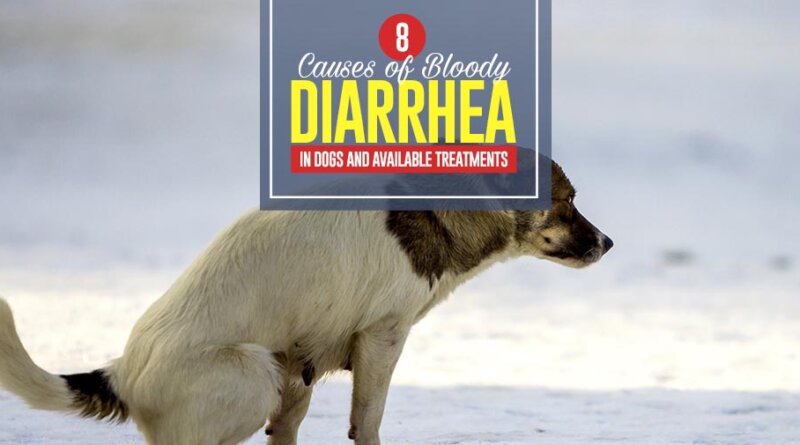8 Causes of Bloody Diarrhea in Dogs, Best Treatments and a Case-Study
When your dog has bloody diarrhea, it can be scary knowing that this could be the symptom of a life-threatening condition.
But, in many cases it’s something far less severe, and will work itself out at home. Either way, bloody diarrhea in dogs needs to be addressed by a veterinarian.
The best thing that you can do for your dog when he has bloody diarrhea is to be astute. Pay attention to changes in his behavior and eating habits.
Research his symptoms, and as soon as you become worried, seek immediate veterinary help. Until then, do not panic.
One of the most serious diseases that shows itself as bloody diarrhea in dogs is something known as Hemorrhagic GastroEnteritis (HGE).
This is the most common serious canine bloody stool condition, but that doesn’t necessarily mean this is what your dog has.
Even if you’re on a tight budget, call your veterinarian first. A vet visit may not be necessary at all.
They will be happy to listen to the symptoms over the phone and give you a quick opinion on what this may be and whether your dog requires any medical attention, or if this is something you can solve at home by yourself.
Bloody diarrhea is a soft, runny stool that can have varying amounts of blood within it. It can potentially be life-threatening in cases of HGE in dogs, or if the diarrhea is severe and accompanies other symptoms.
Mild cases will often resolve themselves and may be caused by food intolerance or a rectal injury in your dog. Let’s take a closer look at this.
ALSO READ: The Best Dog Food for Dogs With Diarrhea and Loose Stools
Symptoms of Bloody Diarrhea in Dogs
If your dog exhibits any of the following symptoms, he may be suffering from something more serious than an upset stomach.
Other than the mentioned Hemorrhagic Gastro Enteritis condition, the illness may also include Parvovirus or parasite infestations.
There are some remedies for a dog’s regular diarrhea, but when there’s blood in your canine’s stool.
It’s time to watch out for some other symptoms (which are likely to accompany bloody stool in your dog) and seek your vet’s guidance.
Symptoms to watch out for:
- Fever
- Vomiting
- Dehydration
- Anemia
- Lethargy
- Weight Loss
- Dullness to the coat
If your dog is experiencing these symptoms, head to or phone your vet immediately.
They will be able to weigh up the different symptoms, make a diagnosis over the phone, and judge whether further medical treatment is required or whether this can be something that is treatable at home.
Do not rely on internet articles for the assessment.
RECIPE: Homemade Dog Food for Diarrhea
What is Bloody Diarrhea in Dogs?
Diarrhea is characterized by frequent bowel movements, with loose and liquidy fecal matter.
A bout of diarrhea isn’t unheard of and can occur from something as simple as a change to your dog’s diet. It may also happen if he has eaten something that he shouldn’t have.
A small case of diarrhea is nothing to worry about. But, when blood begins to appear there could be something more sinister afoot.
First, let me run through some of the causes, symptoms, and treatments of bloody diarrhea in dogs.
Common Causes of Bloody Diarrhea in Dogs And its Treatments
There are numerous reasons for bloody diarrhea in dogs be present, many of these are harmless but some can be life-threatening.
Your job as an owner is to read the signs, recognize changes in your dog’s behavior, and seek veterinary treatment as soon as you suspect that something is wrong.
1. Parvovirus
Canine Parvovirus is a highly contagious viral infection that usually attacks the intestinal tract, but other forms of this disease can attack the heart muscle itself.
The most obvious signs of a dog suffering from parvovirus are:
- Vomiting
- Severe bloody diarrhea in dogs
- Extreme weight loss
- Lethargy
- Fever
- Hypothermia
- Noticeably red mouth and eyes
As this disease is highly infectious your dog can pick it up either through direct contact with another infected animal, by sniffing at an infected canines excrement, or from the fecal matter of an infected dog being trodden on, and brought into the home on shoes.
Treatments for Parvovirus in canines include:
- IV Fluids
- Antibiotics
- Injectable vitamins
- Colostrum in puppies
2. Hookworms
Especially dangerous to young puppies and older dogs with weakened immune systems, these parasites clamp onto the wall of the small intestine and suck blood from their host. Symptoms include
- Anemia
- Pale gums
- Lethargy
- An unhealthy coat, and flaky skin
- Coughing
The hookworm is usually passed on from mother to pup through her milk. Another way that a dog can contract hookworm is through direct skin penetration from the larvae.
Treatments include a parasitic dewormer for dogs and iron supplements.
3. Hemorrhagic GastroEnteritis (HGE)
This condition baffles veterinarians as little is known of how it is caused.
Known to predominantly attack young small breed dogs, this condition is caused by the body reacting adversely to food or bacteria.
This reaction causes proteins, red blood cells, and fluids to leak through the lining of the intestinal tract.
Perhaps most confusing is the fact that this takes place even when no inflammation is present. If your dog is suffering from Hemorrhagic Gastroenteritis, catching it quickly will help greatly, according to case studies from other vets and research.
Keep an eye out for the following symptoms:
- Sudden vomiting
- Bloody diarrhea in dogs with a foul odor
- Depression
- Lethargy
- Weight loss
Most prevalent in young small breed dogs are highly strung and stressed canines.
The unfortunate reality is that all dogs can develop this affliction, and well over ten percent of dogs will suffer from at least one bout of this illness in their lifetime.
Common treatments include antibiotics, IV fluids, and potassium and electrolyte supplements.
ASK A VET: Does Hypoallergenic Dog Food Really Work and Why?
4. Whipworms
The whipworm is especially dangerous as their eggs can survive in just about any environment, from water and food to soil and bedding.
The eggs can survive for years without a host.
One of the more sly parasites, there are often not many outwardly visible symptoms of whipworms. However, extreme cases can lead to serious infection and death.
Most veterinarians advise whipworm checks to take place at least once annually.
Symptoms of this parasite include:
- Dehydration
- Anemia
- Bloody diarrhea in dogs
Any age, breed, and size of dog can contract whipworm. It’s for this reason that hygiene must reign supreme when trying to prevent a case of whipworm.
The treatment for whipworm is a parasitic dewormer.
5. Roundworms

Initially, the eggs are ingested by the dogs where they will progress into larvae before making their way to the digestive tract.
It’s here that these light-colored worms roam freely. feeding off of the partly digested matter.
This may seem less dangerous than a blood-sucking parasite, but when the number of these worms grows it can cause a life-threatening blockage.
Symptoms of a roundworm infestation in your pet can include:
- Lethargy
- Vomiting
- Bloody diarrhea in dogs
- Coughing
- Anorexia
Most commonly, puppies are infected by their mother, either just before birth or whilst nursing.
Roundworms are tricky little devils and can live dormant in dogs for their entire lives. They could also attack and cause incredible health issues.
Similar to other types of worms, the treatment for this parasite is a parasitic dewormer.
RELATED: Can Humans Get Worms From Dogs?
6. Changes in Diet
A change in diet can cause health issues, most notably when changing to a nutritionally deficient foo.
But, issues can occur in sensitive dogs as well or due to food intolerances and allergies with even the most minor change.
Signs that your dog’s new diet is not agreeing with him include:
- Vomiting
- Bloody diarrhea in dogs
- Flatulence
- Weight Loss
- Scratching incessantly
Any dog can suffer from an adverse reaction to changes in its diet.
The trick is to work out whether or not this is a temporary change or whether the new food is harmful to your dog.
It’s best to speak with your veterinarian about the best way to treat your dog’s food intolerance issue. Some treatment options may include:
- Revert to old food if possible
- Allergy testing
- Conduct an elimination diet
7. Inflammatory Bowel Disease (IBD)
In essence, inflammatory bowel disease in dogs (IBD) is the doggy version of irritable bowel syndrome (IBS) that is found commonly in the human population.
This uncomfortable condition is generally caused by the body reacting adversely to normal bacteria in the gut and instigating a defense response that causes inflammation of the bowel.
Common symptoms of Inflammatory Bowel Disease include:
- Bloody diarrhea in dogs
- Lethargy
- Flatulence
- Gurgling stomach
- Dull coat
- Weight Loss
- Vomiting
As with humans, little is known as to what causes this condition. The most likely cause is food sensitivity and allergies.
Treatments include anti-inflammatory medication and diet modification (here’s an IBD-friendly recipe).
8. Rectal Injuries
Rectal injuries are usually caused by your dog eating something that he shouldn’t have, for instance, a piece of bone, rock, or part of a stick.
The indigestible object will pass through the digestive tract and may cause injury to the surrounding areas.
Symptoms include:
- Bloody diarrhea in dogs
- Pain in stomach
- Sensitivity to movement, or touch
- Decreased appetite
- Vomiting
Incredibly playful dogs and those that will put anything in their mouths are the most likely to suffer from this type of injury.
Treatments for rectal injuries will depend on the injury itself but could include surgical removal of scar tissue in extreme cases or antibiotics if an infection takes place.
RELATED: Dog Has Diarrhea? 9 Ways to Prevent and Treat It
Sammy’s Success Story
With all of these possible reasons for your dog to suffer from bloody diarrhea, one diagnosis that everyone keeps their finger crossed to avoid is Parvo.
This highly infectious disease is painful, scary, and life-threatening to those who have become infected.
One unlucky dog that was struck down with this deadly disease was a happy, bouncy chihuahua/beagle mix named Sammy.
We stumbled upon the story on the blog blueanteater.com run by Hayley Cruz. It was, in fact, Hayley’s little brother who was gifted this adorable bundle of joy for Christmas.
Her brother took to dog ownership like a duck to water. In the first few days of her arrival, he wouldn’t even let anyone near little Sammy if he believed that they had recently consumed chocolate!
Puppy training began post haste, and Sammy – the big ball of energy that she was – was doing well.
But then, a mere five days after she arrived at the Cruz home, Hayley came downstairs to find something was wrong.

This was followed reasonably quickly by vomiting. After some serious Googling, the same result popped up – Parvovirus.
That’s when diarrhea kicked in.
Worried about the costs associated with going to the veterinarian, Hayley, her brother, and their mother all tried their very best to research and treat Sammy at home. But, to no avail.
After twenty-four hours with no improvement, they made the decision that would ultimately save Sammy’s life.
They took the dog to the closest veterinarian.
Hayley mentioned how she was nervous that the vet may scold them for not bringing Sammy in sooner, but she said that as luck would have it – and due in part to their home remedies – Sammy was experiencing very little dehydration.
They were told that she should make a full recovery.
With a thorough plan of action for the next two weeks of treatment – including injecting an IV into her once per day and giving her multiple types of medication – the Cruz family left the veterinarians with hope for a bright future for this brave young pup.
At first, the whole family detested poking her with a needle to insert the IV. They knew that they were doing this to help her, but seeing her writhe in pain was somewhat unbearable.
They persisted, and once her treatment was complete, they were overjoyed to welcome the bouncy and energetic Sammy back!

Owners like the Cruz’s are the best example of what a dog owner should be.
Immediately aware of irregular behavior, they researched the symptoms and began treatment immediately.
Even on a tight budget, they didn’t care about the cost and ultimately spent as much money as it took to help Sammy.
As Hayley described it, they didn’t care if it meant that they had to survive on beans, as long as their pup was going to be okay.
What To Do If I See Blood in My Dog’s Stool
Seeing your dog pooping blood and vomiting can be a medical emergency, and it’s best to consult your vet right away. If left untreated, this condition could become fatal to your pooch.
Your vet will instruct you on how to treat bloody diarrhea in dogs, especially at home. At times, bloody diarrhea doesn’t readily go away and might need continuous treatment.
Are Antibiotics Safe?
When your dog has bloody diarrhea and vomiting, one of the most recommended treatments would be antibiotics. They are proven to be very effective when it comes to getting rid of those bacteria.
However, there are some vets who discourage the intake of antibiotics. While they are reliable medications, they can also get rid of the “good” bacteria in a dog’s gut and later disrupt their metabolism, nutrition, and immune system.
How to Prevent Bloody Diarrhea in Dogs
The best way to avoid your dog from pooping blood and vomiting is to keep them away from toxins, scraps, and any foreign objects. If you are switching between dog foods, make sure to have a gradual transition for better adjustment.
You also need to monitor what they are eating and ensure that it’s packed with nutrients. Another way to prevent bloody diarrhea is to stick with your regular vet visits.
Bloody Diarrhea in Dogs: Final Thoughts
It can be scary to see your dog pooping blood and vomiting. You may not know what to do at first. Some dog owners would wait it out and see what happens the next time their dog poops.
However, always remember that bloody diarrhea in dogs is a serious condition, and it shouldn’t be taken lightly. If the problem continues along with vomiting and low energy levels, you ought to rush your pooch to the nearest vet.
Once treated, the vet will tell you how to treat bloody diarrhea in dogs continuously at home. Our dogs have less control over what they put into their mouths. The best way to prevent any of this from happening is to simply monitor what your pooch eats.
READ NEXT: 8 Cancer-Causing Dog Products and How To Avoid Them
Related








I’m not that much of a internet reader to be honest but your blogs really nice, keep it up! I’ll go ahead and bookmark your website to come back later. Many thanks
dark web sites dark web site dark market 2023
Excellent read, I just passed this onto a colleague who was doing some research on that. And he just bought me lunch because I found it for him smile So let me rephrase that: Thank you for lunch!
I want to voice my love for your generosity supporting people that really want guidance on that issue. Your real commitment to getting the message all through came to be amazingly functional and has continually empowered women just like me to get to their aims. Your useful tips and hints means a great deal a person like me and especially to my office colleagues. Regards; from each one of us.
What’s Taking place i am new to this, I stumbled upon this I have discovered It absolutely helpful and it has helped me out loads. I hope to contribute & assist different users like its aided me. Great job.
Spot on with this write-up, I actually assume this website wants rather more consideration. I’ll most likely be once more to learn much more, thanks for that info.
Good ?V I should definitely pronounce, impressed with your website. I had no trouble navigating through all the tabs and related information ended up being truly easy to do to access. I recently found what I hoped for before you know it in the least. Quite unusual. Is likely to appreciate it for those who add forums or something, site theme . a tones way for your customer to communicate. Excellent task..
I like this site its a master peace ! Glad I observed this on google .
Magnificent goods from you, man. I’ve bear in mind your stuff previous to and you’re simply extremely fantastic. I really like what you have obtained right here, certainly like what you are saying and the best way during which you say it. You’re making it enjoyable and you still take care of to keep it smart. I can’t wait to read much more from you. This is actually a tremendous site.
Your place is valueble for me. Thanks!…
Just wanna remark on few general things, The website style is perfect, the subject matter is rattling great. “To the artist there is never anything ugly in nature.” by Franois Auguste Ren Rodin.
mixing xanax with buspirone
Youre so cool! I dont suppose Ive learn something like this before. So nice to find any person with some unique ideas on this subject. realy thanks for beginning this up. this website is something that is needed on the web, somebody with just a little originality. helpful job for bringing something new to the internet!
I cling on to listening to the reports speak about receiving free online grant applications so I have been looking around for the most excellent site to get one. Could you tell me please, where could i acquire some?
What i do not understood is in reality how you’re no longer actually much more smartly-liked than you might be right now. You’re so intelligent. You recognize therefore considerably in the case of this subject, made me for my part consider it from numerous numerous angles. Its like women and men aren’t involved until it’s one thing to do with Girl gaga! Your own stuffs nice. All the time care for it up!